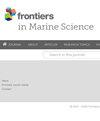Methane seepage activities in the Qiongdongnan Basin since MIS2
IF 2.8
2区 生物学
Q1 MARINE & FRESHWATER BIOLOGY
引用次数: 0
Abstract
Gas hydrates are globally acknowledged as a significant strategic alternative energy source, and there is a consensus on the necessity to enhance their exploration. However, gas hydrates are highly prone to decomposition under variations in external environmental conditions, which can result in subsea methane seepage activities. Consequently, investigating subsea methane seepage activities holds substantial theoretical and practical significance for exploring gas hydrates. This paper evaluates the history of methane seepage activities in the Qiongdongnan Basin (QDNB) by analyzing the carbon and oxygen isotopic characteristics of benthic foraminifera and the geochemical properties of pore water from gravity sediment cores at sites QH-CL4 and QH-CL40. The results indicate that since the Marine isotope stage2 (MIS2), continuous micro-methane seepage activity has been present in the QDNB, characterized by a slight negative deviation in the carbon isotopes of benthic foraminifera. Methane seepage activity intensified during 14.6 ka BP and between 19.64–23.22 ka BP. This increase is thought to be associated with rising seawater temperature during the Bølling–Allerød interstadial and declining sea level during the Last Glacial Maximum, respectively. Moreover, current geochemical characteristics of pore water reveal strong methane seepage activity, with flux as high as 28.968 mmol·mMIS2 以来琼东南盆地的甲烷渗流活动
全球公认天然气水合物是一种重要的战略替代能源,加强对其勘探的必要性已成为共识。然而,天然气水合物在外部环境条件变化时极易分解,从而导致海底甲烷渗流活动。因此,研究水下甲烷渗流活动对勘探天然气水合物具有重要的理论和实践意义。本文通过分析 QH-CL4 和 QH-CL40 地点重力沉积岩芯中底栖有孔虫的碳氧同位素特征和孔隙水地球化学性质,评估了琼东南盆地(QDNB)甲烷渗流活动的历史。结果表明,自海洋同位素第二阶段(MIS2)以来,QDNB 一直存在微甲烷渗流活动,其特征是底栖有孔虫的碳同位素出现了轻微的负偏差。甲烷渗流活动在 14.6 ka BP 和 19.64-23.22 ka BP 期间加剧。这种增加被认为分别与博林-阿勒罗德间歇期海水温度上升和末次冰期海平面下降有关。此外,目前孔隙水的地球化学特征显示,甲烷渗出活动十分活跃,流量高达 28.968 mmol-m-²-a-¹。这种持续不断的活动导致了浅层气体水合物的形成,同时也造成了孔隙水盐度的负偏差。
本文章由计算机程序翻译,如有差异,请以英文原文为准。
求助全文
约1分钟内获得全文
求助全文
来源期刊

Frontiers in Marine Science
Agricultural and Biological Sciences-Aquatic Science
CiteScore
5.10
自引率
16.20%
发文量
2443
审稿时长
14 weeks
期刊介绍:
Frontiers in Marine Science publishes rigorously peer-reviewed research that advances our understanding of all aspects of the environment, biology, ecosystem functioning and human interactions with the oceans. Field Chief Editor Carlos M. Duarte at King Abdullah University of Science and Technology Thuwal is supported by an outstanding Editorial Board of international researchers. This multidisciplinary open-access journal is at the forefront of disseminating and communicating scientific knowledge and impactful discoveries to researchers, academics, policy makers and the public worldwide.
With the human population predicted to reach 9 billion people by 2050, it is clear that traditional land resources will not suffice to meet the demand for food or energy, required to support high-quality livelihoods. As a result, the oceans are emerging as a source of untapped assets, with new innovative industries, such as aquaculture, marine biotechnology, marine energy and deep-sea mining growing rapidly under a new era characterized by rapid growth of a blue, ocean-based economy. The sustainability of the blue economy is closely dependent on our knowledge about how to mitigate the impacts of the multiple pressures on the ocean ecosystem associated with the increased scale and diversification of industry operations in the ocean and global human pressures on the environment. Therefore, Frontiers in Marine Science particularly welcomes the communication of research outcomes addressing ocean-based solutions for the emerging challenges, including improved forecasting and observational capacities, understanding biodiversity and ecosystem problems, locally and globally, effective management strategies to maintain ocean health, and an improved capacity to sustainably derive resources from the oceans.
 求助内容:
求助内容: 应助结果提醒方式:
应助结果提醒方式:


